Miles Dempsey
General Sir Miles Christopher Dempsey, GBE, KCB, DSO, MC (15 December 1896 – 6 June 1969) was a senior British Army officer who served in both world wars. As a junior officer, he fought in France during the First World War, where he was wounded, and served throughout the difficult interwar period, travelling to various corners of the globe.
Sir Miles Dempsey | |
|---|---|
 Lieutenant General Miles Dempsey in April 1944 | |
| Nickname(s) | "Lucky" "Bimbo"[1] |
| Born | 15 December 1896 New Brighton, Wallasey, Cheshire, England[1] |
| Died | 6 June 1969 (aged 72) Yattendon, Berkshire, England |
| Allegiance | United Kingdom |
| Service/ | British Army |
| Years of service | 1915–1947 |
| Rank | General |
| Service number | 9391 |
| Unit | Royal Berkshire Regiment |
| Commands held | Middle East Land Forces (1946–47) Allied Land Forces, South East Asia (1945–46) Fourteenth Army (1945) Second Army (1944–45) XIII Corps (1942–44) 42nd Armoured Division (1941–42) 42nd (East Lancashire) Infantry Division (1941) 46th Infantry Division (1941) 13th Infantry Brigade (1939–40) 1st Battalion, Royal Berkshire Regiment (1938–39) |
| Battles/wars | First World War Second World War Palestine Emergency |
| Awards | Knight Grand Cross of the Order of the British Empire[2] Knight Commander of the Order of the Bath[3] Distinguished Service Order[4] Military Cross[5] Mentioned in Despatches (4)[6][7][8] Army Distinguished Service Medal (United States)[9] Commander of the Legion of Merit (United States)[10] Grand Officer of the Order of Leopold with Palm (Belgium)[11] Croix de guerre with Palm (Belgium)[11] Knight Grand Officer of the Order of Orange-Nassau with Swords (Netherlands)[12] |
During the Second World War he had a close relationship with Bernard Montgomery and commanded the 13th Brigade in France in 1940, and spent the next two years training troops in England, before commanding XIII Corps for the invasions of Sicily and Italy in 1943. He later commanded the Second Army during the Battle of Normandy and made rapid advances in the subsequent campaign in Northern France and Belgium and was the first British Army commander to cross the Rhine. A highly professional and dedicated career soldier who made his reputation in active service, Miles Dempsey was highly thought of by both his superiors and subordinates, most notably Montgomery, although he remains relatively unknown.
Early life and military career
Miles Christopher Dempsey was born in Wallasey, Cheshire on 15 December 1896.[13] He is the descendant of a powerful clan in Offaly and Laois in Ireland with a very long history. His ancestor Terence O'Dempsey, Viscount Clanmalier, was loyal to the Catholic King James II and, as a result, lost all his lands in 1691. Dempsey's branch of the family then left Ireland for Cheshire.[14]
The third and youngest son of Arthur Francis and Margaret Maud Dempsey,[1] Miles Dempsey was educated at Shrewsbury School, entering there in 1911, where he captained the first eleven Cricket team in 1914. On leaving Shrewsbury he attended the Royal Military College, Sandhurst during the First World War.[15][16]
During the First World War Dempsey, aged just 17, volunteered for the British Army and, after graduating from the Royal Military College, Sandhurst in February 1915, six months after the outbreak of war, was commissioned as a second lieutenant into the Royal Berkshire Regiment.[17][18] Promoted to lieutenant in August 1915,[19][20] he served on the Western Front with the 1st Battalion, Royal Berkshires, from June 1916 onwards. The battalion was a Regular Army unit that, as part of the 6th Brigade of the 2nd Division (although by the time of Dempsey's arrival the battalion had been transferred to the 99th Brigade of the same division), had been one of the first units of the British Expeditionary Force (BEF) to be sent overseas and was stationed in billets away from the trenches in the Béthune sector.[21]
Dempsey, serving as a platoon commander in 'D' Company, first saw action during the Battle of Delville Wood in late July 1916, part of the larger Somme offensive. The battalion, although successful in its role, had suffered heavy casualties, including 8 officers, and was relieved in the line and saw little further fighting throughout the year. Dempsey was promoted to acting captain and assumed command of 'D' Company, and later 'B' Company. In November the battalion took part in an assault on Munich Trench, near the River Serre. As at Delville Wood earlier in the year, the assault was successful but with heavy losses, although Dempsey again remained unscathed, and soon returned to England for home leave. In February 1917 he became the adjutant of the battalion.[22]
Following attacks near Miraumont and then Oppy, during which Lance Corporal James Welch was awarded the Victoria Cross (VC), the battalion, badly understrength, thereafter remained in a quiet sector of the front for most of the year, and was temporarily merged with the 23rd (Service) Battalion, Royal Fusiliers. Dempsey was soon posted as a staff officer at II Corps HQ, before returning to the 1st Royal Berkshires, this time in command of 'A' Company. In late November the battalion attacked Bourlon Wood as part of the Battle of Cambrai.[23] On 12 March 1918, as the Germans prepared to launch their Spring Offensive, they laid down a heavy mustard gas barrage on Dempsey's battalion, which was now at La Vacquerie with Dempsey commanding 'D' Company. Dempsey, along with 10 officers and 250 other ranks, was wounded and later evacuated to England, where he had a lung removed.[24] Returning to the battalion in July, where, with the tide of the war having turned, the 1st Royal Berkshires took part in the Hundred Days Offensive until the war ended on 11 November 1918. By then the battalion was at Escarmain.[25] Dempsey was awarded the Military Cross (MC), which was gazetted in the King's Birthday Honours list in June 1919.[5][16]
Between the wars
After the war, in 1919, Dempsey played two first-class cricket matches for Sussex against Oxford University and Northamptonshire.[26] Between 1926 and 1932, he also played Minor Counties Championship cricket for Berkshire.[27]
Dempsey returned to England with the 1st Royal Berkshires after it served in the Allied occupation of the Rhineland, and later, with the battalion, was sent to Iraq in 1919, and later Persia, the following year, where the battalion formed part of North Persia Force (or Norperforce).[28][29] While his battalion was stationed in Persia, Dempsey took up Pelmanism.[30] In late 1921 the battalion moved again, this time to Bareilly, India, and Dempsey took over 'C' Company, but in 1922 returned to England for his first leave in almost three years, returning to India later in the year before returning to England again in 1923, this time to take up an appointment at the Royal Military College, Sandhurst. While there he commanded No. 1 Platoon of No. 1 Company, commanded by Major Richard O'Connor, who had served with distinction during the First World War, and later to serve with Dempsey again, under very different circumstances.[31] Dempsey remained in this post, during which, in 1926, he was able to travel around Europe, until 1927, when he returned to regimental duties, returning to his regiment, although he was posted to the 2nd Battalion, then serving in Germany as part of the British Army of the Rhine (BAOR). Dempsey took over 'B' Company, and spent a large amount of his time travelling, mainly by bicycle, around Europe, visiting old battlefields of old wars, as well as likely scenes of battle in any future conflicts.[32]
In January 1930 Dempsey was admitted to the Staff College, Camberley, graduating in December 1931.[1][33] His fellow students in the Junior Division included numerous future general officers, including William Gott, George Hopkinson, James Steele, George Symes, Maurice Chilton, Walter Mallaby, Arthur Snelling, Stuart Rawlins, John Nichols and Manley James.[33] In the year senior to Dempsey, in the Senior Division attending from 1929–1930, included Neil Ritchie, Herbert Lumsden, George Erskine, Ivor Hughes, Reginald Denning, Harold Redman and Ian Playfair, while in Dempsey's second year, the Junior Division, attending from 1931–1932, included Brian Horrocks, Sidney Kirkman, Frank Simpson, Joseph Baillon, Arthur Dowler, Thomas Rees, Keith Arbuthnott and Cameron Nicholson. The instructors in Dempsey's first year included Henry Maitland Wilson, George Giffard, Henry Willcox, John Clark and James Gammell, and Arthur Percival and John Smyth.[34] Nearly all of these men were to achieve high rank in the upcoming war.[16]
Enjoying his time at the Staff College, Dempsey's first posting after Camberley was as a General Staff Officer Grade 3 (GSO3) to the Military Secretary, where he became responsible for the careers of all officers below the rank of colonel, having access to their annual confidential reports. Dempsey, by now a major (having been promoted in September 1932),[1] held this post until late January 1934, when he handed over to Brian Horrocks upon receiving an appointment as brigade major of the 5th Infantry Brigade.[35] The brigade, commanded by Brigadier Victor Fortune (Francis Nosworthy from 1935), formed part of the 2nd Division, then commanded by Major General Archibald Wavell, was serving in Aldershot Command and took part in numerous large-scale military maneouvres throughout Dempsey's time as brigade major and, after handing over again to Brian Horrocks in February 1936, he returned to the 1st Battalion of his regiment, taking command of HQ Company.[36] The battalion, then stationed in Shorncliffe, Kent, was serving as part of the 10th Brigade of the 4th Division, and shortly after Dempsey's return, the battalion was commanded by Lieutenant Colonel Eric Miles.[37] The following year Dempsey attended a brief course at the Senior Officers' School at Sheerness, before being posted to South Africa, where he served as a GSO2 with the Defence Forces of the Union of South Africa, a posting which he enjoyed.[1] Relinquishing that post in late January 1938, he returned to England soon after to succeed Miles as Commanding Officer (CO) of the 1st Battalion, Royal Berkshires, and receiving a promotion to lieutenant colonel.[38] The battalion, still with the 10th Brigade, was both lacking in modern equipment and severely understrength, although, with the possibility of another war in Europe, the situation slowly changed and new equipment and reservists began arriving.[39]
Second World War
Belgium and France, 1939–1940
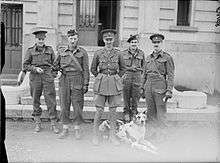
By the start of the Second World War in September 1939 Dempsey's battalion had moved, transferring from Brigadier Evelyn Barker's 10th Brigade to Brigadier Noel Irwin's 6th Brigade, part of the 2nd Division, commanded by Major General Charles Loyd.[16] Dempsey, with his battalion, was sent to France towards the end of the month, as part of the British Expeditionary Force (BEF). In November he was promoted to the acting rank of brigadier[1] and assumed command of the 13th Infantry Brigade in place of Brigadier Henry Willcox, who had been one of Dempsey's instructors at the Staff College in the 1930s, which was already in France.[16] Aged just 42, he was one of the youngest brigadiers in the British Army. The brigade formed part of Major General Harold Franklyn's 5th Division, although by war's beginning the division was still not fully formed and so the brigade was sent to France as an independent formation two months before, and had spent most of its time on guard duties in the BEF's rear areas.[40] The brigade, together with the 15th Infantry Brigade, under Brigadier Horatio Berney-Ficklin, and the 17th Infantry Brigade, under Brigadier Montagu Stopford, rejoined the 5th Division when the division HQ arrived in late December.[41]
In May 1940, the brigade saw action on the retreat from the River Dyle and then fought in the major defensive battle on the River Scarpe. When the Belgian Army surrendered in late May the brigade took part in the holding battle on the Ypres-Comines canal allowing Major General Bernard Montgomery's 3rd Infantry Division to cross their rear and secure the gap created by the Belgian collapse.[40] In the subsequent retreat to Dunkirk the brigade provided part of the rear-guard for the BEF during the Dunkirk evacuation. By the time the 13th Brigade returned to England it was reduced to a strength of less than 500 men, out of an original strength of nearly 3,000. For his services in France, Dempsey was awarded the Distinguished Service Order in July 1940,[4] which was presented to him personally by the GOC, Major General Franklyn, who was soon replaced by Major General Berney-Ficklin.[42][33]
England, 1940–1942
In July 1940 Dempsey took up the appointment of Brigadier General Staff (BGS) to the Canadian Corps[40] until June 1941 when he was appointed acting rank of major general to command of the 46th Infantry Division and then 42nd (East Lancashire) Infantry Division four months later, which was converting to an armoured division.[40] requiring him to implement a huge training programme. Further challenges were presented in May 1942 when the establishment of British armoured divisions was altered to team an armoured brigade with an infantry brigade instead of having two armoured brigades. By the end of the year Dempsey had become well-versed in the direction of combined armoured and infantry formations as well as an experienced trainer of troops.[43]
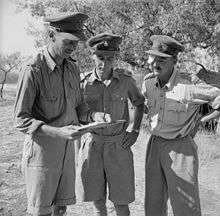
North Africa, Sicily and Italy, 1942–1943
In December 1942 Dempsey was promoted to lieutenant general to command XIII Corps of the British Eighth Army in North Africa. Montgomery, the Eighth Army commander, had first spotted Dempsey's potential when he had been one of his students at the Staff College.[43] On arrival in Cairo, Egypt, Dempsey found his corps HQ in reserve because the long lines of communication to Eighth Army's spearhead could only sustain two corps (XXX Corps and X Corps). Dempsey was therefore employed in the planning of the invasion of Sicily and led his corps in the assault on Sicily in July 1943.
The invasion was spearheaded by airborne forces under Dempsey's command (see operations Ladbroke and Fustian).[44] In early August Dempsey relieved Major General Horatio Berney-Ficklin, commander of the 5th Infantry Division, then under XIII Corps.[45] Towards the end of the campaign, Dempsey's HQ was withdrawn to reserve to plan Operation Baytown, Eighth Army's part in the invasion of Italy across the Strait of Messina.[46] Although his Corps' landing on 3 September was unopposed, the Germans ensured his progress was slow by destroying bridges and culverts on the only routes through the harsh terrain. It took nearly two weeks to advance more than 300 miles (480 km) to the north to link up with the U.S. Fifth Army (which contained, in addition to the U.S. VI Corps, the British X Corps) landing at Salerno as part of Operation Avalanche. Allied forces then commenced to fight their way northward with Fifth Army to the west and Eighth Army to the east of Italy's Apennine Mountain spine.[46] The corps later took part in the Moro River Campaign but the severe winter weather forbade any further progress.
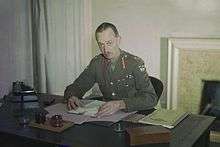
Northwestern Europe, 1944–1945
In North Africa, Sicily and Italy, Montgomery's faith in Dempsey had proved justified and he had also gained a reputation for his expertise in Combined Operations. This prompted Montgomery, when he left Italy at the end of 1943 to take command of the 21st Army Group for the forthcoming D-Day landings, to select Dempsey to command the British Second Army. The Second Army was the main British force (although it also included Canadian Army units) involved in the landings, making successful assaults at Gold, Juno and Sword beaches on 6 June 1944.
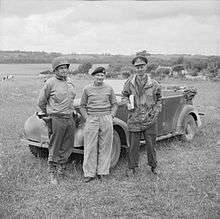
The successful assaults were followed by a battle of attrition during which the Anglo-Canadian forces were frustrated by determined German resistance. This fighting drew vital German units including the bulk of their armoured strength to the Caen sector, facilitating the breakout further west in July (see Operation Cobra) by Lieutenant General George S. Patton's U.S. Third Army.[47] The Second Army then made a rapid advance across northern France into Belgium, liberating Brussels and Antwerp in September 1944. On 15 October 1944, during a visit to the Second Army, King George VI knighted Dempsey on the battlefield. Because of the fast and successful advance over more than 200 miles in a week Dempsey received the nickname of "Two Hundred Miles" Dempsey.
Second Army's XXX Corps (now commanded by Lieutenant General Brian Horrocks) took part in Operation Market Garden, the failed attempt to secure an early crossing of the River Rhine in September 1944, which Dempsey believed could not succeed and openly questioned to Montgomery. Airborne troops secured a succession of canal and river crossings to enable XXX Corps to reach the Lower Rhine at Arnhem and wheel right into Germany. Intelligence had not detected the presence of unexpected German formations in the area and resistance proved greater than expected, frustrating XXX Corps attempts to reach its final objective. During the operation, Dempsey, forward near the front with his Tac HQ, witnessed the crossing of the U.S. 82nd Airborne Division's 504th Parachute Regiment cross the Nijmegen bridge. Impressed, he later wrote that the 82nd was "easily the best division on the Western front".[48] Dempsey met with the 82nd's commander, Brigadier General James M. Gavin, shook him by the hand and said "I am proud to meet the commander of the greatest division in the world today."[49]
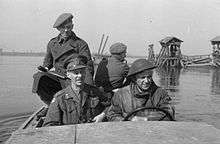
The Second Army, with XII and XXX Corps in the vanguard and II Canadian Corps under command and VIII Corps in reserve eventually crossed the Rhine on 23 March 1945,[50] and Dempsey was the first British Army commander to do so. On 7 April 1945, The Illustrated London News carried a full front page of a specially commissioned portrait painting of Dempsey by artist Arthur Pan.[51] In May, Dempsey's men captured Bremen, Hamburg and Kiel. At 11.00 am on 3 May, a delegation of senior German officers led by General Admiral von Friedeberg arrived at Dempsey's Tac HQ and after questioning it appeared that Friedeberg was a representative of Generalfeldmarschall Keitel and Grand Admiral Dönitz who wished to surrender. In typical fashion Dempsey sent them on their way to report to Montgomery which led to the formal surrender the next day at Lüneberg Heath.
Far East, 1945–1946
After the end of World War II in Europe, Dempsey was appointed to the command of the British Fourteenth Army and GOC in C Malaya Command[52] and then Land Force Commander, South East Asia. By the time he had arrived however, the war in the East was also over.[53] Within his command were 123,000 British and Dutch prisoners and nearly 750,000 captured Japanese.
Miles Dempsey, although modest and unassuming, was considered to be a highly competent officer. He asserted a very effective control over the Second Army (United Kingdom) without taking the limelight. This was despite the stalemate in Normandy and the failure to advance beyond Antwerp and thus ensure that German forces remained isolated. He was described thus by military historian Carlo D'Este:
A career infantryman, Dempsey was an ardent student of military history and during the interwar period had frequently visited Europe to study its battlefields firsthand. Blessed with an active and incisive mind, a phenomenal memory and a unique skill in reading maps, Dempsey would soon leave his army staff in awe over his ability to remember everything he saw on a map, to bring a landscape literally to life in his mind even though he had never actually seen it. This talent proved particularly important during the crucial battles around Caen in June and July 1944. Dempsey was considered the Eighth Army's best expert in combined operations and, as he grew in experience, Montgomery soon recognized his potential for army command. The two men shared many qualities, including a disdain for paperwork and a determination, based on their First World War experiences, never to waste their soldiers lives.[54]
Post-war career
In 1946 he was appointed Commander-in-Chief (C-in-C) of Middle East Land Forces, and was in command throughout the Palestine Emergency. He was made acting general in June 1946[55] which was made permanent in October 1946[56] and was appointed to the ceremonial post of Aide de Camp general to the King.[57] Dempsey retired from the British Army in August 1947.[58] In 1950, he was given a 'shadow' appointment as Commander In Chief, British Home forces which he relinquished in 1956.[59] He held the ceremonial posts of Colonel Commandant of the Royal Military Police, (1947 to 1957)[60][61] as well as the Special Air Service (1951–1960)[62][63] and Colonel of the Regiment of the Princess Charlotte of Wales Royal Berkshire Regiment (1946 to 1956).[64][65] He was also Honorary Colonel of the Territorial army's 21st SAS Regiment (Artists Rifles) from 1948 to 1951.[66][67]
In 1948, Dempsey married Viola O'Reilly, the youngest daughter of Captain Percy O'Reilly of Coolamber, County Westmeath, Ireland.[68]
He was Chairman of the Race Course Betting Board, H&G Simonds, Greene King and Sons (the first non-family chairman) and Deputy Chairman of Courage Ltd. He was commissioned as a Deputy Lord Lieutenant in the county of Berkshire in 1950.[69]
Dempsey declined to write any memoirs about his military experiences. He ordered that his diaries be burned.[70]
Death
After returning to England from visiting a nephew in Kenya, Dempsey was diagnosed with cancer. He died soon afterwards, on 6 June 1969, at the age of 72, exactly 25 years after D-Day.[71][72] He is buried at Yattendon churchyard, Berkshire.[73]
Tributes
- In September 1944, Sir Miles Dempsey was made an honorary citizen of the city of Caen in Normandy, France.
- Around 1990, a street in Caen (avenue Général Dempsey) was named after him,[74] in a district close to the Mémorial pour la Paix museum, where many of the streets commemorate personalities linked with the Second World War. The street links the avenue Maréchal Montgomery to the avenue Amiral Mountbatten.
- In the Dutch town of Langenboom a street was named after him (Dempseystraat).
- In the small Belgian town of Hamont-Achel, General Sir Miles Dempsey and his Second Army held their headquarters here, from September 1944 until April 1945. In his honour, the street was named Generaal Dempseylaan.
- In Singapore, Dempsey Hill and Dempsey Road are named after him.[75]
Notes
- "British Army officer histories". Unit Histories. Retrieved 28 June 2017.
- "No. 40669". The London Gazette (Supplement). 30 December 1955. p. 6.
- "No. 36586". The London Gazette. 27 June 1944. p. 3069.
- "No. 34893". The London Gazette (Supplement). 9 July 1940. p. 4261.
- "No. 31371". The London Gazette (Supplement). 30 May 1919. p. 6826.
- "No. 34904". The London Gazette (Supplement). 23 July 1940. p. 4579.
- "No. 37213". The London Gazette (Supplement). 7 August 1945. p. 4044.
- "No. 37521". The London Gazette (Supplement). 2 April 1946. p. 1672.
- "No. 38178". The London Gazette (Supplement). 13 January 1948. p. 401.
- "No. 37027". The London Gazette (Supplement). 10 April 1945. p. 1947.
- "No. 37853". The London Gazette (Supplement). 16 January 1947. p. 324.
- "No. 37909". The London Gazette (Supplement). 18 March 1947. p. 1315.
- "Miles Dempsey biography at Spartacus Educational". Archived from the original on 31 December 2013.
- "the select surnames website". www.selectsurnames2.com. Retrieved 3 May 2017.
- Rostron 2010, pps. 1-2
- Smart, p. 81
- Rostron 2010, p. 4-5
- "No. 29292". The London Gazette (Supplement). 10 September 1915. p. 9066.
- Rostron 2010, p. 5
- "No. 29489". The London Gazette. 25 February 1916. p. 2101.
- Rostron 2010, p. 6
- Rostron 2010, p. 10
- Rostron 2010, p. 11
- Rostron 2010, p. 12
- Rostron 2010, p. 13-14
- "First-Class Matches played by Miles Dempsey". CricketArchive. Retrieved 22 June 2012.
- "Minor Counties Championship Matches played by Miles Dempsey". CricketArchive. Retrieved 22 June 2012.
- English, p. 52
- Rostron 2010, pps. 15-23
- Rostron 2010, p. 24
- Rostron 2010, pps. 25-28
- Rostron 2010, pps. 28-29
- Smart, p. 82
- Rostron, pps. 30-31
- Rostron 2010, pps. 34-35
- Smart 2010, pps. 36-38
- Rostron, p. 39
- Rostron 2010, p. 40
- Rostron, p. 40
- Mead 2007, p. 117
- Rostron 2010, pps. 42-43
- Rostron 2010, p. 49
- Mead 2007, p. 118
- Rostron 2010, pps. 62-65
- Rostron 2010, p. 66
- Mead 2007, p. 119
- Mead 2007, p. 120
- Rostron 2010, p. 143
- Rostron 2010, p. 141
- Mead 2007, pp. 120–121
- "The Illustrated London News 1945", iln.org.uk. Retrieved 19 September 2009.
- "Army Commands" (PDF). Archived from the original (PDF) on 5 July 2015. Retrieved 3 May 2017.
- Mead 2007, p. 121
- D'Este 2004, p. 60.
- "No. 37648". The London Gazette (Supplement). 9 July 1946. p. 3607.
- "No. 37764". The London Gazette (Supplement). 18 October 1946. p. 5191.
- "No. 37781". The London Gazette (Supplement). 5 November 1946. p. 5461.
- "No. 38051". The London Gazette (Supplement). 19 August 1947. p. 3933.
- "No. 40698". The London Gazette (Supplement). 27 January 1956. p. 639.
- "No. 37990". The London Gazette (Supplement). 17 June 1947. p. 2772.
- "No. 41034". The London Gazette (Supplement). 26 March 1957. p. 6169.
- "No. 39176". The London Gazette (Supplement). 16 March 1951. p. 1498.
- "No. 42004". The London Gazette (Supplement). 8 April 1960. p. 2640.
- "No. 37823". The London Gazette (Supplement). 17 December 1946. p. 6169.
- "No. 40928". The London Gazette (Supplement). 16 November 1946. p. 6564.
- "No. 38237". The London Gazette (2nd supplement). 12 March 1948. p. 1866.
- "No. 39270". The London Gazette (Supplement). 26 June 1951. p. 3538.
- Harvey, Dan (2020). A Bloody Victory: The Irish at War’s End, Europe 1945. Merrion Press. ISBN 978-1785373336.
- "No. 39053". The London Gazette. 27 October 1950. p. 5362.
- Hamilton, Nigel (1983). Master of the Battlefield Monty's War Years 1942–1944. McGraw-Hill Book Company. p. 697.
- "D-Day General Dies", Pittsburgh Press, June 6, 1969, p1
- "Obituary— General Sir Miles Dempsey", The Guardian, June 7, 1969, p3
- Rostron 2010, p. 200
- Caen map, La Poste, 1993.
- "Dempsey". www.dempseyhill.com. Retrieved 3 May 2017.
References
- D'Este, Carlo (2004) [1983]. Decision in Normandy: The Real Story of Montgomery and the Allied Campaign. London: Penguin. ISBN 0-14-101761-9. OCLC 44772546.CS1 maint: ref=harv (link)
- English, John (2009). Patton's Peers: The Forgotten Allied Field Army Commanders of the Western Front, 1944–45. Stackpole Books. ISBN 978-0-8117-0501-1.
- Mead, Richard (2007). Churchill's Lions. Stroud, Gloucestershire: Spellmount. ISBN 978-1-86227-431-0.CS1 maint: ref=harv (link)
- Rostron, Peter (2010). The Military life and times of General Sir Miles Dempsey, Monty's Army Commander. South Yorkshire (England): Pen & Sword Military. ISBN 9781844684885.CS1 maint: ref=harv (link)
- Smart, Nick (2005). Biographical Dictionary of British Generals of the Second World War. Barnesley: Pen & Sword. ISBN 1844150496.
External links
| Wikimedia Commons has media related to Miles Dempsey. |
| Military offices | ||
|---|---|---|
| Preceded by Douglas Wimberley |
GOC 46th Infantry Division June–October 1941 |
Succeeded by Harold Freeman-Attwood |
| Preceded by Eric Miles |
GOC 42nd (East Lancashire) Infantry Division October–November 1941 |
Post redesignated 42nd Armoured Division |
| New title | GOC 42nd Armoured Division 1941–1942 |
Succeeded by John Aizlewood |
| Preceded by Brian Horrocks |
GOC XIII Corps 1942–1943 |
Succeeded by Sidney Kirkman |
| Preceded by Kenneth Anderson |
GOC Second Army 1944–1945 |
Post disbanded |
| Preceded by Sir William Slim |
GOC Fourteenth Army July–November 1945 |
Post disbanded |
| New title | GOC Malaya Command November – December 1945 |
Succeeded by Sir Frank Messervy |
| New title | C-in-C Middle East Land Forces 1946–1947 |
Succeeded by Sir John Crocker |
| Honorary titles | ||
| Preceded by Robert Collins |
Colonel of the Royal Berkshire Regiment 1946–1956 |
Succeeded by Dudley Hogg |